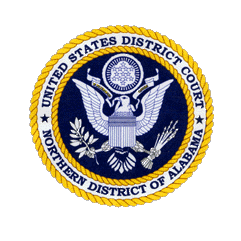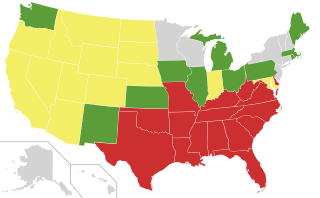
The Fourteenth Amendment to the United States Constitution was adopted on July 9, 1868, as one of the Reconstruction Amendments. Usually considered one of the most consequential amendments, it addresses citizenship rights and equal protection under the law and was proposed in response to issues related to former slaves following the American Civil War. The amendment was bitterly contested, particularly by the states of the defeated Confederacy, which were forced to ratify it in order to regain representation in Congress. The amendment, particularly its first section, is one of the most litigated parts of the Constitution, forming the basis for landmark Supreme Court decisions such as Brown v. Board of Education (1954) regarding racial segregation, Roe v. Wade (1973) regarding abortion, Bush v. Gore (2000) regarding the 2000 presidential election, and Obergefell v. Hodges (2015) regarding same-sex marriage. The amendment limits the actions of all state and local officials, and also those acting on behalf of such officials.

The Fifteenth Amendment to the United States Constitution prohibits the federal government and each state from denying or abridging a citizen's right to vote "on account of race, color, or previous condition of servitude." It was ratified on February 3, 1870, as the third and last of the Reconstruction Amendments.
Plessy v. Ferguson, 163 U.S. 537 (1896), was a landmark U.S. Supreme Court decision in which the Court ruled that racial segregation laws did not violate the U.S. Constitution as long as the facilities for each race were equal in quality, a doctrine that came to be known as "separate but equal". Notably the court ruled the existence of laws based upon race was not inherently racial discrimination. The decision legitimized the many state laws re-establishing racial segregation that had been passed in the American South after the end of the Reconstruction era (1865–1877).
The Civil Rights Cases, 109 U.S. 3 (1883), were a group of five landmark cases, including US v. Stanley, in which the Supreme Court of the United States held that the Thirteenth and Fourteenth Amendments did not empower Congress to outlaw racial discrimination by private individuals. The holding that the Thirteenth Amendment did not empower the federal government to punish racist acts done by private citizens would be overturned by the Supreme Court in the 1968 case Jones v. Alfred H. Mayer Co. The Fourteenth Amendment not applying to private entities, however, is still valid precedent to this day. Although the Fourteenth Amendment-related decision has never been overturned, in the 1964 case of Heart of Atlanta Motel, Inc. v. United States, the Supreme Court held that Congress could prohibit racial discrimination by private actors under the Commerce Clause, though that and other loose interpretations of the Clause to expand federal power have been subject to criticism.
Guinn v. United States, 238 U.S. 347 (1915), was a United States Supreme Court decision that found certain grandfather clause exemptions to literacy tests for voting rights to be unconstitutional. Though these grandfather clauses were superficially race-neutral, they were designed to protect the voting rights of illiterate white voters while disenfranchising black voters.
Regents of the University of California v. Bakke, 438 U.S. 265 (1978) was a landmark decision by the Supreme Court of the United States which involved a dispute of whether preferential treatment for minorities can reduce educational opportunities for whites without violating the Constitution. It upheld affirmative action, allowing race to be one of several factors in college admission policy. However, the court ruled that specific racial quotas, such as the 16 out of 100 seats set aside for minority students by the University of California, Davis, School of Medicine were impermissible.
Loving v. Virginia, 388 U.S. 1 (1967), was a landmark civil rights decision of the U.S. Supreme Court in which the Court ruled that laws banning interracial marriage violate the Equal Protection and Due Process Clauses of the Fourteenth Amendment to the U.S. Constitution. The case involved Mildred Loving, a woman of color, and her white husband Richard Loving, who in 1958 were sentenced to a year in prison for marrying each other. Their marriage violated Virginia's Racial Integrity Act of 1924, which criminalized marriage between people classified as "white" and people classified as "colored". The Lovings appealed their conviction to the Supreme Court of Virginia, which upheld it. They then appealed to the U.S. Supreme Court, which agreed to hear their case.
Boynton v. Virginia, 364 U.S. 454 (1960), was a landmark decision of the US Supreme Court. The case overturned a judgment convicting an African American law student for trespassing by being in a restaurant in a bus terminal which was "whites only". It held that racial segregation in public transportation was illegal because such segregation violated the Interstate Commerce Act, which broadly forbade discrimination in interstate passenger transportation. It moreover held that bus transportation was sufficiently related to interstate commerce to allow the United States federal government to regulate it to forbid racial discrimination in the industry.
Board of Trustees of the University of Alabama v. Garrett, 531 U.S. 356 (2001), was a United States Supreme Court case about Congress's enforcement powers under the Fourteenth Amendment to the United States Constitution. The Supreme Court decided that Title I of the Americans with Disabilities Act was unconstitutional, insofar as it allowed states to be sued by private citizens for money damages.

33°30′58.7″N86°48′40.2″W
McLaurin v. Oklahoma State Regents, 339 U.S. 637 (1950), was a United States Supreme Court case that prohibited racial segregation in state supported graduate or professional education. The unanimous decision was delivered on the same day as another case involving similar issues, Sweatt v. Painter.
The Equal Protection Clause is part of the first section of the Fourteenth Amendment to the United States Constitution. The clause, which took effect in 1868, provides "nor shall any State ... deny to any person within its jurisdiction the equal protection of the laws." It mandates that individuals in similar situations be treated equally by the law.
Gomillion v. Lightfoot, 364 U.S. 339 (1960), was a landmark decision of the Supreme Court of the United States that found an electoral district with boundaries created to disenfranchise African Americans violated the Fifteenth Amendment.
Sipuel v. Board of Regents of the University of Oklahoma, 332 U.S. 631 (1948), is a per curiam United States Supreme Court decision involving racial segregation toward African Americans by the University of Oklahoma and the application of the Fourteenth Amendment to the United States Constitution.
Racial discrimination in jury selection is specifically prohibited by law in many jurisdictions throughout the world. In the United States, it has been defined through a series of judicial decisions. However, juries composed solely of one racial group are legal in the United States and other countries. While the racial composition of juries is not dictated by law, racial discrimination in the selection of jurors is specifically prohibited. Depending on context, the phrases "all-white jury" or "all-black jury" can raise the expectation that deliberations may be unfair.
Arthur Davis Shores was an American civil rights attorney who was considered Alabama's "drum major for justice".

Harlan Hobart Grooms was a United States district judge of the United States District Court for the Northern District of Alabama.

In the United States, anti-miscegenation laws were passed by most states to prohibit interracial marriage, and in some cases also prohibit interracial sexual relations. Some such laws predate the establishment of the United States, some dating to the later 17th or early 18th century, a century or more after the complete racialization of slavery. Nine states never enacted such laws; 25 states had repealed their laws by 1967, when the United States Supreme Court ruled in Loving v. Virginia that such laws were unconstitutional in the remaining 16 states. The term miscegenation was first used in 1863, during the American Civil War, by journalists to discredit the abolitionist movement by stirring up debate over the prospect of interracial marriage after the abolition of slavery.

In the United States, school integration is the process of ending race-based segregation within American public and private schools. Racial segregation in schools existed throughout most of American history and remains an issue in contemporary education. During the Civil Rights Movement school integration became a priority, but since then de facto segregation has again become prevalent.






